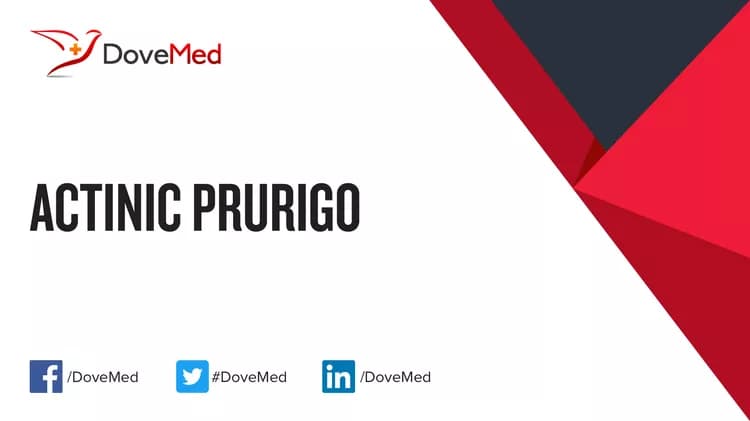What are the Other Names for this Condition? (Also known as/Synonyms)
- Hutchinson’s Prurigo
What is Actinic Prurigo? (Definition/Background Information)
- Actinic Prurigo is a rare skin condition characterized by intensely itchy bumps on the skin, possibly caused by an abnormal reaction to sunlight
- The condition affects individuals of all skin types and ages, though individuals of Latin-American and native American descent are more susceptible to it
- It has been suggested that there may be a genetic component that predisposes individuals to Actinic Prurigo
- The skin condition persists throughout the year, although Actinic Prurigo can become more intense during summer months
- Limiting exposure to the sun and protecting oneself with sunscreen are the best preventative measures against this condition
- Topical steroids, emollients, hydroxychloroquine, and thalidomide medications have been used to treat Actinic Prurigo with varying degrees of success
Who gets Actinic Prurigo? (Age and Sex Distribution)
- Actinic Prurigo affects people of all skin types and ages. Approximately, 30% of those affected are children
- When the condition occurs in childhood, both genders may be equally affected. However, if the onset of disease occurs in adulthood, women are more prone to the condition than men
- Individuals of Latin American and Native American descent are more susceptible to Actinic Prurigo
- Those living at high altitudes and in sunny climates are at a higher risk for Actinic Prurigo
What are the Risk Factors for Actinic Prurigo? (Predisposing Factors)
The risk factors for Actinic Prurigo may include:
- Extensive exposure to sun
- Living in high altitudes
- Being of Latin American and Native American descent
- A family history of the condition
- Having the human leukocyte antigen subtype (HLA) DRB1*0407
It is important to note that having a risk factor does not mean that one will get the condition. A risk factor increases one's chances of getting a condition compared to an individual without the risk factors. Some risk factors are more important than others.
Also, not having a risk factor does not mean that an individual will not get the condition. It is always important to discuss the effect of risk factors with your healthcare provider.
What are the Causes of Actinic Prurigo? (Etiology)
- The exact cause of Actinic Prurigo is not entirely understood, but there is strong evidence to suggest that the condition occurs as a result of exposure to long and short wave ultraviolet radiation
- The condition begins with small pink bumps on areas of the skin that have been exposed to the sun
- It has recently been suggested that there may be a genetic component predisposing some individuals to the condition. The following findings support this theory:
- Actinic Prurigo runs in some families
- An increased frequency of human leukocyte antigen (HLA) DRB1*0407 has been recorded in individuals with Actinic Prurigo
What are the Signs and Symptoms of Actinic Prurigo?
The signs and symptoms of Actinic Prurigo may include the following:
- Presence of intensely itchy skin rashes
- Small, red, and inflamed bumps
- Exposed raw skin and skin wounds from chronic scratching
- The face, lips, and conjunctiva are the most commonly affected areas
How is Actinic Prurigo Diagnosed?
The diagnosis of Actinic Prurigo is made on the basis of the following tests and exams:
- A thorough physical examination and clinical assessment of symptoms
- An evaluation of ethnic descent as well as family history of the condition
- A tissue biopsy to confirm a diagnosis and/or rule out other skin conditions such as atopic dermatitis
Many clinical conditions may have similar signs and symptoms. Your healthcare provider may perform additional tests to rule out other clinical conditions to arrive at a definitive diagnosis.
What are the Possible Complications of Actinic Prurigo?
There are no major complications associated with Actinic Prurigo; however, the condition has been found to become more intense during the summer months.
How is Actinic Prurigo Treated?
Actinic Prurigo is chronic and currently there is no treatment for the condition. The affected individuals often experience worsening of symptoms during the summer months.
Some treatment options that help to reduce the symptoms of Actinic Prurigo include:
- Limiting exposure to the sun
- Use of emollients and topical corticosteroids
- Use of prescription medicines hydroxychloroquine and thalidomide
How can Actinic Prurigo be Prevented?
The following methods may be helpful in preventing the occurrence of Actinic Prurigo:
- Limiting exposure to the sun
- Wearing adequate sun protection while outdoors
- Opting for routine physical/skin examination
Educating oneself about symptoms of the condition, particularly if one is of Latin American or Native American descent, or if the condition runs in the family. This will allow the affected individuals to seek medical attention as soon as symptoms appear.
What is the Prognosis of Actinic Prurigo? (Outcomes/Resolutions)
Actinic Prurigo is a chronic skin condition that has presently no available treatment measures.
- Those affected by Actinic Prurigo are advised to avoid exposure to the sun to the extent possible
- In childhood-onset cases, there have been rare instances of the condition resolving completely by itself on entering adulthood
Additional and Relevant Useful Information for Actinic Prurigo:
- Sunburns occur following an exposure to ultraviolet (UV) light, either from the sun or from any other artificial source (such as from lamps during a tan)
The following resource can help you understand sunburn:
Related Articles
Test Your Knowledge
Asked by users
Related Centers
Related Specialties
Related Physicians
Related Procedures
Related Resources
Join DoveHubs
and connect with fellow professionals


0 Comments
Please log in to post a comment.